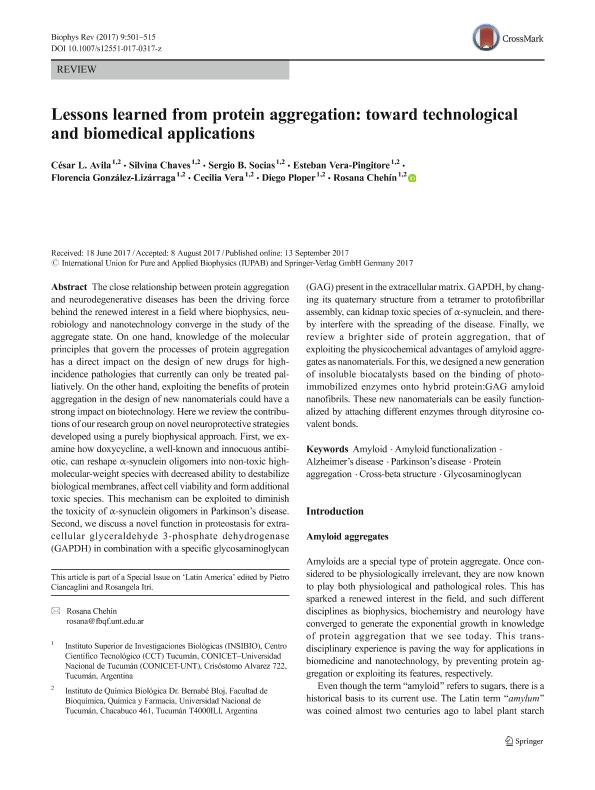Artículo
Lessons learned from protein aggregation: toward technological and biomedical applications
Avila, Cesar Luis ; Chaves, Analia Silvina
; Chaves, Analia Silvina ; Socias, Sergio Benjamin
; Socias, Sergio Benjamin ; Vera Pingitore, Esteban
; Vera Pingitore, Esteban ; González Lizarraga, Maria Florencia
; González Lizarraga, Maria Florencia ; Vera, Claudia Cecilia
; Vera, Claudia Cecilia ; Ploper, Diego
; Ploper, Diego ; Chehin, Rosana Nieves
; Chehin, Rosana Nieves
 ; Chaves, Analia Silvina
; Chaves, Analia Silvina ; Socias, Sergio Benjamin
; Socias, Sergio Benjamin ; Vera Pingitore, Esteban
; Vera Pingitore, Esteban ; González Lizarraga, Maria Florencia
; González Lizarraga, Maria Florencia ; Vera, Claudia Cecilia
; Vera, Claudia Cecilia ; Ploper, Diego
; Ploper, Diego ; Chehin, Rosana Nieves
; Chehin, Rosana Nieves
Fecha de publicación:
10/2017
Editorial:
Springer Verlag Berlín
Revista:
Biophysical Reviews
ISSN:
1867-2450
e-ISSN:
1867-2469
Idioma:
Inglés
Tipo de recurso:
Artículo publicado
Clasificación temática:
Resumen
The close relationship between protein aggregation and neurodegenerative diseases has been the driving force behind the renewed interest in a field where biophysics, neurobiology and nanotechnology converge in the study of the aggregate state. On one hand, knowledge of the molecular principles that govern the processes of protein aggregation has a direct impact on the design of new drugs for high-incidence pathologies that currently can only be treated palliatively. On the other hand, exploiting the benefits of protein aggregation in the design of new nanomaterials could have a strong impact on biotechnology. Here we review the contributions of our research group on novel neuroprotective strategies developed using a purely biophysical approach. First, we examine how doxycycline, a well-known and innocuous antibiotic, can reshape α-synuclein oligomers into non-toxic high-molecular-weight species with decreased ability to destabilize biological membranes, affect cell viability and form additional toxic species. This mechanism can be exploited to diminish the toxicity of α-synuclein oligomers in Parkinson’s disease. Second, we discuss a novel function in proteostasis for extracellular glyceraldehyde 3-phosphate dehydrogenase (GAPDH) in combination with a specific glycosaminoglycan (GAG) present in the extracellular matrix. GAPDH, by changing its quaternary structure from a tetramer to protofibrillar assembly, can kidnap toxic species of α-synuclein, and thereby interfere with the spreading of the disease. Finally, we review a brighter side of protein aggregation, that of exploiting the physicochemical advantages of amyloid aggregates as nanomaterials. For this, we designed a new generation of insoluble biocatalysts based on the binding of photo-immobilized enzymes onto hybrid protein:GAG amyloid nanofibrils. These new nanomaterials can be easily functionalized by attaching different enzymes through dityrosine covalent bonds.
Archivos asociados
Licencia
Identificadores
Colecciones
Articulos(INSIBIO)
Articulos de INST.SUP.DE INVEST.BIOLOGICAS
Articulos de INST.SUP.DE INVEST.BIOLOGICAS
Citación
Avila, Cesar Luis; Chaves, Analia Silvina; Socias, Sergio Benjamin; Vera Pingitore, Esteban; González Lizarraga, Maria Florencia; et al.; Lessons learned from protein aggregation: toward technological and biomedical applications; Springer Verlag Berlín; Biophysical Reviews; 9; 5; 10-2017; 501-515
Compartir
Altmétricas



